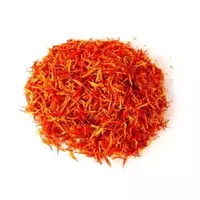Imereti saffron

The world-famous spice Imereti saffron is a dried leaves of a perennial plant that belongs to the Astrov family and is called marigold. We think everyone is familiar with these small flowers with a bright orange or yellow color of inflorescences, which litter all domestic flower beds in the warm season. Interestingly, the Latin name of the plant Tagetes, which in translation means the name of a young young man of the grandson of the god Jupiter. There are more than five dozen varieties of marigold, but only a few of them are used in cooking.
Imereti saffron was used as a spice by ancient tribes in pre-Columbian America. After conquering the colonies on the American continent, the spice Imereti saffron (marigolds) fell into the New World. In addition to the generally accepted and scientific name, Imereti saffron (marigolds) have a dozen regional names. For example, in the post-Soviet territory, the spice is called marigold for the similarity of the surface of flower petals with the fabric of the same name.
In England, Imereti saffron is treated with respect, as can be seen from the name of the spice, which is literally translated as "gold of the Virgin Mary. " Often, the plant and spice are not called Imereti saffron, but carbobenedict. Dried marigold leaves are used in cooking. Essential oil and leaves of the plant are actively used in cosmetology and medicine. Dried marigold flowers are used to prepare healing infusions, which are used in folk medicine as a powerful sweating and diuretic.
Marigold plants are cultivated, as well as Imereti saffron spice is produced in countries such as the USA, Morocco, Congo, Canada, Georgia, the Russian Federation, France, Belgium, South America, Chile and Mexico. In order to obtain the spice, Imereti saffron (marigold) flowers of the plant are dried and then ground into powder. The aroma of Imereti saffron is quite unique. The spice has a pronounced floral aroma, in which fruit notes are present.
Imereti saffron is best combined with meat and fish dishes. The spice is used as a dye of natural origin. The Imereti saffron added to the sauce colors the final product yellow and gives a subtle fruity aroma. Imereti saffron is used in the production of low-alcohol drinks, tinctures or liqueurs. Usually, just a pinch of Imereti saffron is enough to completely change the taste and aroma of the final dish.
Dried buds of marigold are used whole for manufacture of marinades, vegetable seams, vinegar or oil. Undiscovered buds of velvet flowers give the taste a subtle floral taste and aroma. It should be remembered that often under the guise of Imereti saffron in eastern bazaars can sell turmeric, which is considered a cheaper spice. It is not difficult to distinguish one spice from another, you just need to remember that the dried petals of marigolds are yellow, and turmeric is distinguished by its rich bright orange color.
Imereti saffron 310 kCal
Energy value of Imereti saffron (Ratio of proteins, fats, carbohydrates - ju):
Proteins: 11.43 g (~ 46 kCal)
Fats: 5.85 g (~ 53 kCal)
Carbohydrates: 61.47 g (~ 246 kCal)
Energy ratio (bj | y): 15% | 17% | 79%
 Español
Español Français
Français Português
Português Русский
Русский 简体中文
简体中文 繁體中文
繁體中文 日本語
日本語 한국어
한국어 العربية
العربية Türkçe
Türkçe Қазақ
Қазақ Deutsch
Deutsch Italiano
Italiano Українська
Українська
